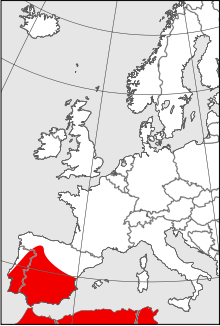Lemonia philopalus
Lemonia philopalus is a species of moth of the family Brahmaeidae (older classifications placed it in Lemoniidae).[1] It is found from Spain up to Egypt and North Africa.
| Lemonia philopalus | |
|---|---|
| Scientific classification | |
| Kingdom: | Animalia |
| Phylum: | Arthropoda |
| Class: | Insecta |
| Order: | Lepidoptera |
| Family: | Brahmaeidae |
| Genus: | Lemonia |
| Species: | L. philopalus |
| Binomial name | |
| Lemonia philopalus (Donzel, 1842) | |
 | |
| Synonyms | |
| |
The wingspan is 50–65 millimetres (2.0–2.6 in).[2] The moth flies from October to February depending on the location.
Subspecies
- Lemonia philopalus philopalus
- Lemonia philopalus vasquezi Oberthür, 1916
Sources
- Kitching I, Rougerie R, Zwick A, Hamilton C, St Laurent R, Naumann S, Ballesteros Mejia L, Kawahara A (2018) A global checklist of the Bombycoidea (Insecta: Lepidoptera). Biodiversity Data Journal 6: e22236. https://doi.org/10.3897/BDJ.6.e22236
- Patrice Leraut (2006). "Moths of Europe: Saturnids, lasiocampids, hawkmoths, tiger moths". N.A.P. Editions: 144. Cite journal requires
|journal=(help)
- P.C.-Rougeot, P. Viette (1978). Guide des papillons nocturnes d'Europe et d'Afrique du Nord. Delachaux et Niestlé (Lausanne).
gollark: ++remind "19:30" try BQN
gollark: ++remind "18:30 tomorrow" ................
gollark: ++remind "18:30" ................
gollark: ++remind "19:30 tomorrow" sorry, oops
gollark: ++remind "7am tomorrow" find shirt!
This article is issued from Wikipedia. The text is licensed under Creative Commons - Attribution - Sharealike. Additional terms may apply for the media files.